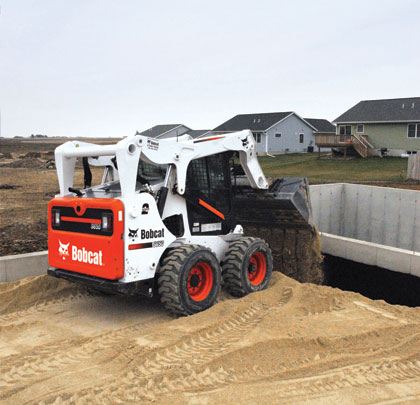There was once a time when skid steers and compact loaders served a very specific and limited purpose. Legend has it the skid-steer loader was invented in the 1950s as a more maneuverable and lighter-weight solution for cleaning out two-story turkey barns. Those days are long gone, and with them went the one-size-fits-all tire.
As skid-steers grew in popularity, so did their range of available accessories. The decades to follow gave way to an insurmountable number of attachments that put skid-steers into all sorts of new applications—from farm, landscaping, and sensitive turf applications, to paving, construction, and harsh industrial settings. As the limitations of compact equipment have diminished, the need for specialty tires has grown significantly.
Having spent more than 40 years in the OTR tire industry—and the last 16 years as head of research and development at Titan Tire Corporation—Dana Zahuranec has excellent insight into what has shaped the industry over the years and what is likely to shape it in the future. He believes one of the biggest factors in tire innovation has been the increased versatility of equipment.
“When skid-steers were limited to general applications, a general-purpose tire was sufficient,” says Zahuranec, “but the variety of applications has really sparked innovation in the tire industry. Now, it’s all about picking the right tire for the job. Today’s tire manufacturers make nearly every design decision based on application—from tread design and tread compound, to overall tire construction.”
Zahuranec goes on to explain that this trend is not limited to the small equipment market.
MARKET SYNERGIES
“One of the biggest changes we’ve seen over the years is in the size of equipment being introduced,” says Zahuranec. “There was a time when 100-ton haul trucks were the standard for mining, but now 400-ton trucks are common, and we’re all the way up to 63-inch tires. These 63-inch tires not only have to carry huge loads, but they’re expected to hold up in extremely harsh settings on equipment that is running at faster speeds than ever before. This has required significant innovation in tire design.”
The innovation of tires in various markets has left tire manufacturers with quite an arsenal of tire designs, many of which Zahuranec says can influence tire design across other markets.
“We often take what we’ve learned designing for one market and apply that to another,” says Zahuranec. “For instance, what we’ve learned from developing mining tires can be applied to designing small OTR tires for skid steers that work in extreme, rocky conditions. There are a lot of parallels between markets.”
With the arsenal of tire designs out there, the average contractor has a dizzying array of options. Zahuranec explains it in simple terms.
“Choose a tire based on the surface you expect to work on most regularly, whether that’s pavement, dirt, rock, or turf.”
SELECTION BASED ON SURFACE
Selecting the right tire for a particular surface is often as easy as selecting the appropriate tread design, according to Zahuranec.
“For pavement and asphalt, you’ll want to select a tire that has a low void-to-lug ratio. The more rubber on the road, the smoother ride you’ll have, and the longer the tread will last,” he says. “On the other hand, an R4 tire with a high void-to-lug ratio would provide better traction in dirt, sand, and snow. If you expect to work on both hard and soft surfaces pretty regularly, it’s best to go with a standard skid-steer design, which features a high void-to-lug ratio at the shoulder of the tire and a lower void-to-lug ratio toward the center.”
Further delving into specialty tires, there are tread designs that cater to both ends of the spectrum—from sensitive turf, to severe, rocky applications.
“If you are working primarily on sensitive turf—for instance, a golf course—the button lugs of an R3 tread design will help minimize ground disturbance, while the rounded shoulders of the tire prevent rutting when turning the wheel,” says Zahuranec. “On the other hand, if you’re working in severe conditions, you should consider a heavy-duty tire with deep lugs and more of a diamond tread pattern, as you’d expect to see on a mining tire. These tires often feature cut-resistant compounds and thicker sidewalls.”
FUTURE OUTLOOK
In addition to taking design cues from mining and agriculture, Zahuranec believes we’ll see the small OTR tire market influenced by the way mining and agriculture tires are developed and serviced.
“In mining, we’re seeing a very heavy focus on tire maintenance and fleet tire management. Part of that is ensuring we are putting tire experts out in the field to assess the end-users’ needs based on their application. That’s exactly what we’re doing with the Titan Mining Services division we launched last year,” says Zahuranec. “I believe the wave of the future is connecting tire experts with the end user in order to solve real-world challenges—both from a service perspective and from a tire design perspective. That’s what we’ve done with the Grizz Squad.”
In June 2012, Titan launched the Grizz Squad—a team of field service experts that responds to customer requests with a site visit. The information gathered during these site visits is then relayed to the Titan research and development team and used to improve tire designs to meet the new challenges faced by end users on the job.
“With OEs, dealers, and tire manufacturers all taking more of an application-specific approach to products and services, I expect nothing but innovation in the coming years; this innovation will ultimately result in improved performance on the job and happier contractors,” says Zahuranec. ■
For More Information:
For more information about Titan Tire Corporation, visit www.titan-intl.com.
_________________________________________________________________________
Modern Contractor Solutions, September 2013
Did you enjoy this article?
Subscribe to the FREE Digital Edition of Modern Contractor Solutions magazine.

The Past, Present, and Future of Skid Steer Tires


